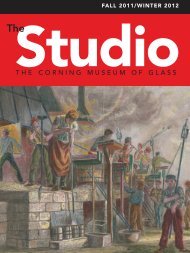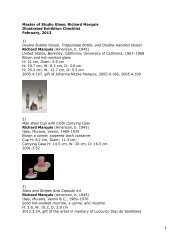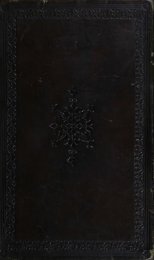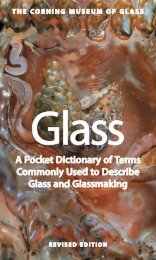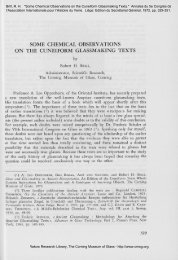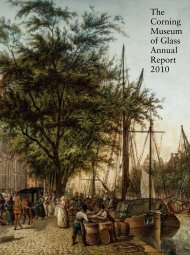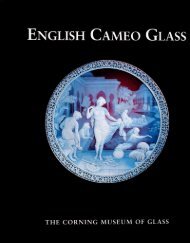Curiosities of Glassmaking - Corning Museum of Glass
Curiosities of Glassmaking - Corning Museum of Glass
Curiosities of Glassmaking - Corning Museum of Glass
Create successful ePaper yourself
Turn your PDF publications into a flip-book with our unique Google optimized e-Paper software.
Vase Imitating Jade<br />
China, 19th century<br />
Blown glass<br />
56.6.5, gift <strong>of</strong> Mrs. E. C. Chadbourne<br />
Cup Imitating Turquoise<br />
China, 1912–1949<br />
Blown glass<br />
56.6.8, gift <strong>of</strong> Mrs. E. C. Chadbourne<br />
<strong>Glass</strong> Shoe<br />
Frederick Carder (American, born in England, 1863–1963)<br />
United States, <strong>Corning</strong>, New York, Steuben Division, <strong>Corning</strong> <strong>Glass</strong><br />
Works, 1925<br />
Mold-blown glass<br />
66.4.74<br />
This glass slipper was designed for a movie production <strong>of</strong> Cinderella, but<br />
the film was never completed.<br />
―Leather‖ Glove<br />
Fulvio Bianconi (Italian, 1915–1996)<br />
Italy, Murano, Venini, 1948<br />
Optic-blown and hot-worked glass; gold-foil decoration<br />
L.238.3.2000, lent by The Steinberg Foundation<br />
Scientists tell us that glass is a state <strong>of</strong> matter rather than a single<br />
material. It is formed when a molten material cools so rapidly that there<br />
is not enough time for the material’s crystalline structure to re-form.<br />
Obsidian, for example, is rock in a glassy state, just as hard candy is<br />
sugar in a glassy state. In nature, glasses are formed when sand and<br />
rocks are heated to high temperatures and then cooled rapidly.<br />
Chunk <strong>of</strong> Obsidian<br />
Collected in the United States<br />
Volcanic glass; metallic inclusions<br />
62.7.3, gift <strong>of</strong> George D. MacBeth<br />
Obsidian is formed when molten volcanic rock from the interior <strong>of</strong> the<br />
earth (lava) cools rapidly.<br />
Chunk <strong>of</strong> Obsidian<br />
Collected in California<br />
Volcanic glass<br />
63.7.12, gift <strong>of</strong> Fred P. Bentley<br />
Spearheads<br />
United States, about 1000–1500<br />
Hand-chipped volcanic glass<br />
62.7.1, gift <strong>of</strong> The Santa Barbara <strong>Museum</strong> <strong>of</strong> Natural History<br />
<strong>Glass</strong>y materials have a shiny surface and they show curved, conchoidal<br />
(shell-like) fractures. The edges <strong>of</strong> these spearheads display this<br />
characteristic type <strong>of</strong> fracture.<br />
Obsidian Knife<br />
Possibly Mexico, 1200–1521<br />
Hand-chipped volcanic glass<br />
7



